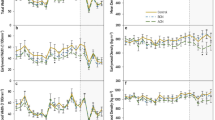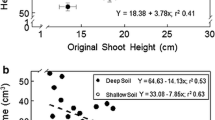Abstract
The thickness of bark (cork) is of utmost importance for its industrial processing and, therefore, for the sustainable management of cork oak (Quercus suber L.) woodlands. Cork thickness has been reported to decrease from the stem base upwards but, to our knowledge, prediction models have not yet been presented. This study intended to develop reliable models to predict stem profiles of cork thickness. We addressed the relationship between bark thickness and stem height by measuring stem diameters and cork thickness at various stem heights in 76 trees. Through a repeated measure ANOVA, we selected the bark thickness response variables, cork-ring width and cork thickness. A mixed-effect modelling approach was used to fit linear bark thickness curves with stem height. Our results showed that the equations that performed better for cork thickness were functions of the stem relative height and cross-sectional cork area increment. The decreasing trend upwards the stem might lead to underestimation of cork thickness at the base, more than overestimate it at upper stem parts, in relation to the values at breast height, which are generally used to estimate the thickness of the whole cork plank. Furthermore, cork thickness curves were tree size-related, with larger trees exhibiting a steeper reduction in cork thickness upwards the stem.





Similar content being viewed by others
References
Araki MG, Utsugi H, Kajimoto T, Han Q, Kawasaki T, Chiba Y (2010) Estimation of whole-stem respiration, incorporating vertical and seasonal variations in stem CO2 efflux rate, of Chamaecyparis obtuse trees. J For Res Jpn 15:115–122. https://doi.org/10.1093/treephys/tps127
Brackmann K, Qi J, Gebert M, Jouannet V, Schlamp T, Grünwald K, Wallner E-S, Novikova DD, Levitsky VG, Agustí J, Sanchez P, Lohmann JU, Greb T (2018) Spatial specificity of auxin responses coordinates wood formation. Nat Commun 9:875. https://doi.org/10.1038/s41467-018-03256-2
Catry F, Moreira F, Pausas JG, Fernandes PM, Rego F, Cardillo E, Curt T (2012) Cork oak vulnerability to fire: the role of bark harvesting, tree characteristics and abiotic factors. PLoS ONE 7(6):e39810. https://doi.org/10.1371/journal.pone.0039810
Costa A, Barbosa I (2019) Stem diameter and height as traits linked to cork quality (thickness and porosity) in cork oak (Quercus suber L.). In: Materials research proceedings, vol 14, pp 1–6. http://dx.doi.org/10.21741/9781644900413-1
Costa A, Pereira H (2010) Influence of cutting direction of cork planks on the quality and porosity characteristics of natural cork stoppers. For Syst 19(1):51–60. https://doi.org/10.5424/fs/2010191-01166
Costa A, Oliveira AC, Vidas F, Borges JG (2010) An approach to cork oak forest management planning: a case study in southwestern Portugal. Eur J For Res 129:233–241. https://doi.org/10.1007/s10342-009-0326-y
Costa A, Nunes LC, Spiecker H, Graça J (2015) Insights into the cork oak (Quercus suber L.) responsiveness to bark harvesting. Econ Bot 69(2):171–184. https://doi.org/10.1007/s12231-015-9305-z
Costa A, Barbosa I, Roussado C, Graça J, Spiecker H (2016) Climate response of cork growth in Mediterranean oak (Quercus suber L.) woodlands of southwestern Portugal. Dendrochronologia 38:72–81. https://doi.org/10.1016/j.dendro.2016.03.007
Fernandes R (2005) Estudo da influência do calibre e da qualidade das pranchas de cortiça delgada no rendimento do processo fabril de produção de discos de cortiça natural. Graduate Thesis Lisbon University, Lisbon
González F, González JR, García de Ceca JL, González M (2001) Variabilidad de los parametros característicos del corcho en plancha con la altura de extracción. In: Proceedings of the III Congreso Forestal Español Montes para la Sociedad del Nuevo Milenio, Granada, Spain, pp 6
Graves SJ, Rifai SW, Putz FE (2014) Outer bark thickness decreases more with height on stems of fire-resistant than fire-sensitive Floridan oaks (Quercus spp.: Fagaceae). Am J Bot 101(12):2183–2188. https://doi.org/10.3732/ajb.1400412
ISO 2017 ISO1216:2017 Boiled cork—grading, classification and packing) that commercial (boiled) cork planks which are adequate for natural cork stoppers industry
Kijidani Y, Ohshiro N, Matsumura J, Koga S (2014) Effects of crown length on indole acetic acid (IAA) amounts in cambial region tissues in lower and upper trunks of sugi cultivars (Cryptomeria japonica) in September. J Wood Sci 60(4):235–242. https://doi.org/10.1007/s10086-014-1400-8
Laasasenaho J, Melkas T, Aldn S (2005) Modelling bark thickness of Picea abies with taper curves. For Ecol Manag 206:35–47. https://doi.org/10.1016/j.foreco.2004.10.058
Li R, Weiskittel AR (2011) Estimating and predicting bark thickness for seven conifer species in the Acadian Region of North America using a mixed-effects modelling approach: comparison of model forms and subsampling strategies. Eur J For Res 130(2):219–233. https://doi.org/10.1007/s10342-010-0423-y
Listopad CM, Köbel M, Príncipe A, Gonçalves P, Branquinho C (2018) The effect of grazing exclusion over time on structure, biodiversity, and regeneration of high nature value farmland ecosystems in Europe. Sci Total Environ 610:926–936. https://doi.org/10.1016/j.scitotenv.2017.08.018
Machado DP (1935) Contribuição para o estudo da formação da cortiça no sobreiro. Revista Agronómica 23:75–104
Mendes MP, Cherubini P, Plieninger T, Ribeiro L, Costa A (2019) Climate effects on stem radial growth of Quercus suber L.: does tree size matter? Forestry 92(1):73–84. https://doi.org/10.1093/forestry/cpy034
Montero G, Vallejo R (1992) Variacion del calibre del corcho medido a distintas alturas. Invest Agrar Sist Recur For 1(2):181–188
Natividade JV (1934) Cortiças – Contribuição para o estudo do melhoramento da qualidade. Direcção Geral dos Serviços Florestais e Aquícolas, Lisboa
Natividade JV (1950) Subericultura. Ministério da Agricultura, Pescas e Alimentação, Direcção-Geral das Florestas, Lisbon, Portugal
Paulo JA, Pereira H, Tomé M (2017) Analysis of variables influencing tree cork caliper in two consecutive cork extractions using cork growth index modelling. Agroforest Syst 91:221–237. https://doi.org/10.1007/s10457-016-9922-2
Pausas JG, Pereira JS, Aronson J (2009) The tree. In: Aronson J, Pereira JS, Pausas JG (eds) Cork oak woodlands on the edge. Society for Ecological Restoration International/Island Press, Washington, pp 11–21
Pereira H (1998) O calibre e a porosidade como parâmetros da qualidade tecnológica da cortiça em prancha. Rev Florest x1(2):46–50
Pereira H (2007) Cork: biology, production and uses. Elsevier Publications, Amsterdam. https://doi.org/10.1016/B978-044452967-1/50013-3
Pereira H, Melo B, Pinto R (1994) Yield and quality in the production of cork stoppers. Holz als Roh-und Werkstoff 52:211. https://doi.org/10.1007/BF02619093
Sánchez-González M, Calama R, Cañellas I, Montero G (2007) Variables influencing cork thickness in spanish cork oak forests: a modelling approach. Ann For Sci 64(3):301–312. https://doi.org/10.1051/forest:2007007
Seo Y, Lee D, Choi J (2015) Growth analysis of Red Pine (Pinus densiflora) by stem analysis in the Eastern Region of Korea. J For Environ Sci 31(1):47–54. https://doi.org/10.7747/JFES.2015.31.1.47
Sousa EMR, Debouzie D (1999) Distribution spatio-temporelle des attaques de Platypus cylindrus F. (coleopteran: Platypodidae) dans des peuplements de chênes-lièges au Portugal. IOBC Bull 22:47–58
Sumida A, Miyaura T, Torii H (2013) Relationships of tree height and diameter at breast height revisited: analyses of stem growth using 20-year data of an even-aged Chamaecyparis obtusa stand. Tree Physiol 33:106–118. https://doi.org/10.1093/treephys/tps127
Taco C, Lopes F, Pereira H (2003) La variation dans l’arbre de l’épaisseur du liége et du dos des planches de liége pour des chênes-liéges en pleine production. Ann Inst Sup Agronom 49:209–221
Trincado G, Burkhart HE (2006) A generalized approach for modeling and localizing stem profile curves. For Sci 52(6):670–682. https://doi.org/10.1093/forestscience/52.6.670
Valentine HT, Mäkelä A, Green EJ, Amateis RL, Mäkinen H, Ducey MJ (2012) Models relating stem growth to crown length dynamics: application to loblolly pine and Norway spruce. Trees Struct Funct 26:469–478. https://doi.org/10.1007/s00468-011-0608-0
West PW (1980) Use of diameter increment and basal area increment in tree growth studies. Can J For Res 10:71–77. https://doi.org/10.1139/x80-012
Wilhelmsson L, Arlinger J, Spangberg K, Lundqvist S, Grahn T, Hedenberg OT, Olsson L (2002) Models for predicting wood properties in stem of Picea abies and Pinus Sylvestris in Sweden. Scand J For Res 17:330–350. https://doi.org/10.1080/02827580260138080
Acknowledgements
The authors thank Rui Alves for allowing the study design, tree selection and cork sampling, in the cork oak woodland of Companhia das Lezírias, S.A. We also thank the collaboration of Pedro Sousa in the forest inventory and cork sampling, and Graça Oliveira for her valuable support in improving the English reading of the manuscript. Furthermore, the authors thank the comments and suggestions of two anonymous referees that clearly helped to improve the manuscript.
Funding
OakRegeneration project (Promoting agricultural set aside areas towards new oak natural regeneration hotspots) supported by FEADER PDR2020 (PDR2020-101-031071); National Protocol INIAV, I.P. & Companhia das Lezírias S.A.—“Variability of cork thickness and porosity at individual tree level”; Project UID/AMB/04085/2013 supported by national funds through the Foundation for Science and Technology (FCT); SuberInStress project supported by PORLisboa2020 and Foundation for Science and Technology (FCT) (PTDC/BIA/FBT/29704-2017). Augusta Costa’s work was partially funded by Foundation for Science and Technology (FCT), Post-doctoral Grant Number SFRH/BPD/97166/2013.
Author information
Authors and Affiliations
Contributions
A.C. conceived the study and provided the data. A.C. and I.B. performed the analysis. C.M. contributed to the discussion of the obtained results and the writing of the original draft. M.P. contributed with the laboratory facilities and resources for the cork sample’s image analysis. All the authors contributed with the final writing, review and editing.
Corresponding author
Additional information
Communicated by Miren del Rio.
Publisher's Note
Springer Nature remains neutral with regard to jurisdictional claims in published maps and institutional affiliations.
Electronic supplementary material
Below is the link to the electronic supplementary material.
Rights and permissions
About this article
Cite this article
Costa, A., Barbosa, I., Pestana, M. et al. Modelling bark thickness variation in stems of cork oak in south-western Portugal. Eur J Forest Res 139, 611–625 (2020). https://doi.org/10.1007/s10342-020-01273-9
Received:
Revised:
Accepted:
Published:
Issue Date:
DOI: https://doi.org/10.1007/s10342-020-01273-9




